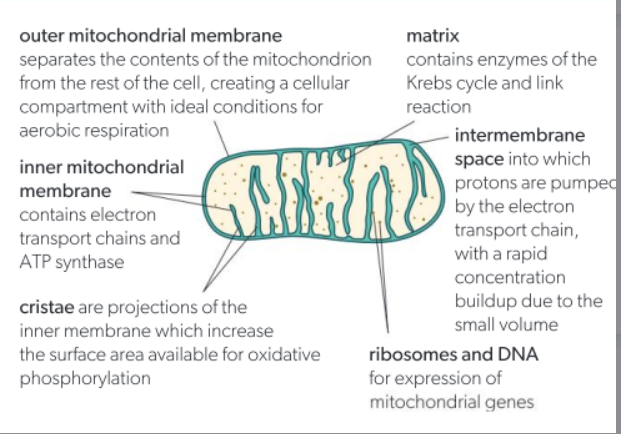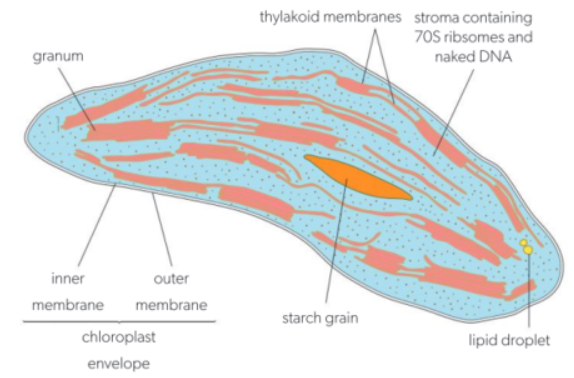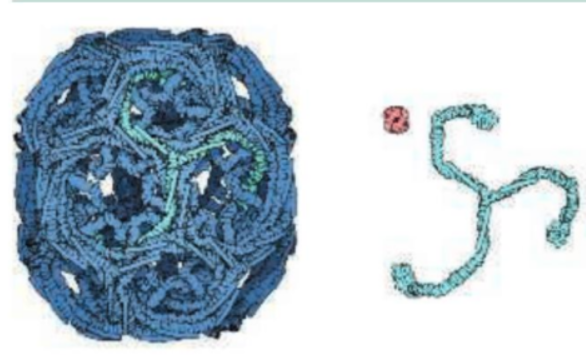- IB DP Biology 2025 SL- IB Style Practice Questions with Answer-Topic Wise-Paper 1
- IB DP Biology 2025 HL- IB Style Practice Questions with Answer-Topic Wise-Paper 1
- IB DP Biology 2025 SL- IB Style Practice Questions with Answer-Topic Wise-Paper 2
- IB DP Biology 2025 HL- IB Style Practice Questions with Answer-Topic Wise-Paper 2
What are organelles?
- discrete structures in cells
- adapted to perform one or more vital functions
- efficient since specialized
What are the different types of organelles?
Different types of organelles are:
-single/double membrane, encloses fluid contents
-solid structure, composed of proteins/RNA, not membrane bound
Name 5 organelles with no membrane.
5 organelles with no membrane are:
-ribosomes
-centrioles
-microtubules
-proteasomes
-nucleoli
Name 6 organelles w/ single membrane.
6 organelles w/ single membrane are:
-vesicles/vacuoles
-rough endoplasmic reticulum
-smooth endoplasmic reticulum
-golgi apparatus
-lysosomes
Name 5 organelles w/ double membrane.
5 organelles w/ double membrane are:
-nuclei
-mitochondria
-chloroplasts
-amyloplasts
-chromoplasts
Name the structures not considered organelles?
structures not considered organelles are:
-cell walls
-cytoskeletons
-cytoplasm
Name the ones which are not considered organelles due to not being discrete enough.
-cytoskeletons
-cytoplasm
What is not considered organelles due to being an extracellular structure?
Cell wall is not considered organelles due to being an extracellular structure.
What are the advantages separation nucleus and cytoplasm?
-In Eukaryotes: keeps chromosomes inside nucleus, safeguards DNA and allows mRNA to be modified after transcription and before translation (post-transcriptional modification).
-In Prokaryotes : no nucleus so DNA and ribosomes together in cytoplasm, translation happens directly after transcription
Give 5 advantages of compartmentalization in cytoplasm.
5 advantages of compartmentalization in cytoplasm are:
-enzymes/substrates are more concentrated for processes.
-substances that could cause damage to cell kept inside membrane organelle, eg. digestive enzyme in lysosome
-conditions (pH) maintained at ideal level for particular processes.
-organelles w/ contents can be moved around cell
-larger area membrane (for process happen within/across membranes)
Q1. What is the function of mitochondria and ATP/aerobic cell respiration: outer membrane?
Ans . It separates contents mitochondrion from rest of cell, compartment specialized for biochemical reactions.
Q2. What is the function of mitochondria and ATP/aerobic cell respiration: Inter membrane spaces?
Ans . It is between inner/outer membranes ,where high concentration protons generated by electron transport chains. Small volume , so concentration gradient across inner membrane builds up rapidly.
Q3. What is the function of mitochondria and ATP/aerobic cell respiration: matrix?
Ans. It is fluid filling compartment inside inner mitochondrial membrane, contains all enzymes/substrates for Krebs cycle and link reaction. By concentrating enzymes in small volume matrix, reactions of two parts of aerobic respiration are performed more rapidly than if dispersed in cytoplasm.

Name 6 adaptations of chloroplast for photosynthesis.
6 adaptations of chloroplast for photosynthesis are :
-double membrane forming outer chloroplast envelope
-extensive system inner membranes (thylakoids), intense green colour due to chlorophyll
-small fluid-filled spaces inside thylakoids
-colourless fluid around thylakoids (stroma), contains diff. enzymes
-stack of thylakoids=grana
-if chloroplast photosynthesizing rapidly maybe starch gains/lipid droplets in stroma

Name 3 functions chloroplasts.
3 functions of chloroplasts are:
-absorb light
-produce ATP by photophosphorylation
-carry out chem. reactions of Calvin cycle
Q1. Give functions of chloroplasts: absorb light.
Ans. Functions of chloroplasts: absorb light are:
-pigment molecules arranged in photosystems in thylakoid membrane, light absorption
-large area=large light-absorbing capacity
-more brightly illuminated leaf=chloroplasts w/deep grana of many thylakoids (more light absorbed)
Q2. Give functions of chloroplasts: produce ATP by photophosphorylation.
Ans. Functions of chloroplasts: produce ATP by photophosphorylation are:
–proton gradient needed, develops b/w inside and outside thylakoids
-volume fluids inside thylakoids small so when protons pumped in proton gradient develops quickly, allows ATP synthesis to begin.
Q3 .Give functions of chloroplasts: carry out chem. reactions Calvin cycle
Ans. Functions of chloroplasts: carry out chem. reactions Calvin cycle are:
-enzymes needed for Calvin cycle kept together w/substrates and products (in stroma)
-concentration speeds up Calvin cycle
-ATP and NADP needed, easily available b/w thylakoids (where produced) distributed throughout stroma
Why does a nucleus need a double membrane?
Nucleus need a double membrane for:
-unusually large pores through nuclear membrane (larger than channel proteins)
-during mitosis and meiosis nuclear membranes break down, allowing chromosomes to move to poles of cell
Give examples of materials and processes that need large pores/double membrane (nucleus).
Examples of materials and processes that need large pores/double membrane (nucleus) are:
-proteins synthesized by ribosomes needed in nucleus need to enter from cytoplasm
-mRNA/tRNA/ribosomes in nucleus exported into cytoplasm
How does double membrane create large pores? (nucleus)
Double membrane use to make larger pore with inner and outer membrane connected to form circular hole. Rims of these nuclear pores lined with proteins that control entry and passing
How is the nuclear membrane breakdown achieved with double membrane?
Vesicles bud off, progressively breaking nuclear membrane into vesicles due to phospholipid bilayer nature and later fused together to make new nuclear membrane.
What are ribosomes?
Ribosomes are:
-large assemblages rRNA and proteins
-eukaryotic ribosomes= 30nm,
-has two subunits
small=binding site mRNA
large= 3 binding sites, tRNA, area catalyzes formation peptide bonds, exit tunnel for synthesized protein
What are free ribosomes?
Ribosomes not attached to membranes are known as free ribosomes.
What happens to proteins synthesized by free ribosomes?
Proteins synthesized by free ribosomes are released into cytoplasm. They remain there/enter nucleus/absorbed by chloroplast/absorbed by mitochondria.
What if ribosome synthesizes protein that must be transported to a specific location?
-Ribosome becomes attached to rER (made of cisternae)
-protein passes into lumen of rER
-transported by vesicles that buds off from rER
-initial destination=Golgi apparatus

State the structure/function Golgi apparatus.
Golgi apparatus is a sack of flattened sacs (cisternae) where proteins made by rER are processed, transported from rER in vesicles. Enzymes in cisternae can change proteins (eg. add carbohydrate=make glycoprotein) .Proteins are transported to destination by vesicles.
Where do proteins that are being secreted go?
Proteins that are being secreted go in plasma membrane.
How is proteins processed in Golgi apparatus?
It is sequential, move from cis to trans side . There are two models to explain movement:
Vesicle transport model
–cisternae don’t move
-vesicles transfer proteins between them
Cisternal maturation model
-vesicles from rER coalesce (come together to form one mass) to form new cisternae on cis side
-gradually move through Golgi until reach trans side, where break up into vesicles
What is the structure/function vesicles in cells?
Vesicles are:
-rounded sacs made of single layer membrane and material inside it
-small, dynamic, continuously made/moved/merged within cells
How are vesicles made?
Vesicles are made by pinching off small area of a membrane , endocytosis , where, protein clathrin helps with process.
What is protein clathrin?
Protein clathrin are:
-3-legged protein
-becomes positioned on inner face PM when vesicle being made
-adjacent clathrin molecules bind to each other to form lattice of pentagons/hexagons
-process helps PM to become indented and eventually detach to form sphere of membrane with clathrin cage around it.

Give reasons why vesicles can be used to move materials around inside cell?
Reason 1:
-contents of vesicles need to be moved
-eg. transport of neurotransmitters to presynaptic membrane of neuron
Reason 2:
-membrane of vesicle/proteins in membrane are the reason for vesicle movement
-in growing cell area of PM needs to increase, phospholipids synthesized next to rER become inserted into rER membrane
-ribosomes on rER synthesize membrane proteins, also become inserted into membrane
-vesicles bud off rER, move to PM, fuse with it increasing area
-same method can be used to increase size of organelles in cytoplasm